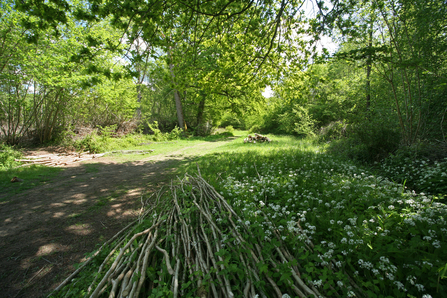
Many of our woods have been in existence since the last ice-age and provide the richest places for wildlife. Most of them have been managed in a careful and sustainable way over the centuries to provide woodland products and fuel. Woods often show signs of traditional management which provided an excellent mixture of trees, shrubs and ground plants for wildlife.
In order to restore old woodlands to their former glory, it is often necessary to reintroduce the traditional ways of looking after them. Use this factsheet as a guide, but be aware that woodland management is complex and varies across the county, so please don't hesitate to contact us for specific advice.
Coppicing with standards
From before the early Middle Ages until the late nineteenth century most woodlands were coppiced. This involves the periodic cutting back of trees or shrubs to ground level, leaving them to sprout new stems from the cut stumps. This gives rise to the rapid production of small round wood which was used for broom handles, firewood, fencing stakes and hurdles.
Coppicing encourages the growth of woodland flowers such as bluebells, primroses and violets by allowing light to the woodland floor. Coppicing is best suited to ancient woodlands, which were coppiced in the past.
Coppice woodlands also provided large trees for timber called ‘standards’. These were often oak and were allowed to grow very large before being felled. When planning coppicing, woodlands should be divided into compartments or ‘coupes’ which can be cut on a rotation. In general the best rotation is every seven to 15 years.
If the coppice is left much longer than 20 years, it may become less valuable and harder to cut. Coppicing is labour intensive, so you may like to consider leaving some coupes to develop naturally.
Not all types of tree respond to coppicing. The best trees to coppice are hazel, willow, alder, field maple, sweet chestnut, small leaved lime, ash and oak.
Deer
If you want to coppice in Suffolk, you must protect it from grazing deer, otherwise you risk killing your trees. Twigs can be placed over cut shoots or you can use spare twigs to build a ‘dead hedge’ around the coupe.
Glades and rides
Glades are open patches in woodland and rides are wide grassy tracks. These places provide light for woodland wildflowers to flourish and areas for insects such as butterflies to feed and breed.
Rides and glades must be maintained to stop them from becoming overgrown. One of the best ways is to create a mixture of grasses and shrubs through mowing and cutting. For large woods, rides can be up to 20-30m wide and a glade can be about half the size of a typical football pitch.
For both glades and rides, grassy areas should be cut each year in the autumn. Taller ground plants on the edges should be cut every two years at the same time.
The shrubby edge should be cut every 5 to 10 years during the winter months. All grass cuttings should be removed, but twigs and other ‘brash’ can be piled up to provide important cover for animals.
Glades
It is very important that the glade is big enough so that sunlight reaches the ground, even in the middle of winter. It is best if it is fringed by big trees to provide shelter.
Glades can be created along rides by ‘scalloping’ the edges to create a sunny, open area. This works best on the north side of an east-west ride as it allows sun to reach the ground throughout the year.
Rides
It is important that a ride is not cut in one go. Mow alternate edges each year and this will help to ensure there are always areas of tall plants for insects and other animals to eat.
Dead wood
Old, dying and dead standing trees and fallen dead wood provide food for almost a thousand types of animal and many types of fungus, lichen and moss. Take some of the following steps to provide dead wood for wildlife:
• Where there is no risk to people, leave dead or dying trees standing for as long as possible. They will provide an excellent habitat for a wide range of wildlife such as bats, woodpeckers and many insect species
• Do not break up stumps or piles of dead or rotting wood. A whole fallen tree is better for wildlife than one that has been cut up
• Consider increasing the amount of dead wood by ‘ring barking’ unwanted trees
• Brushwood and timber from clearing and coppicing should be left in piles or turned into ‘dead hedges’. As well as providing dead wood, it will provide nesting places for birds and small mammals.
Thinning
Newly planted woodlands or those which show no signs of being coppiced may require little management apart from the thinning of trees. Thinning involves the removal of poor, weak, diseased or overcrowded trees to make the remaining trees stronger and sturdier. Thinning can also be used to manage neglected woodland where dense shading has reduced the growth of woodland wildflowers and shrubs.
On average it should be carried out every five to 10 years. It is important to take advice on how to do this.
